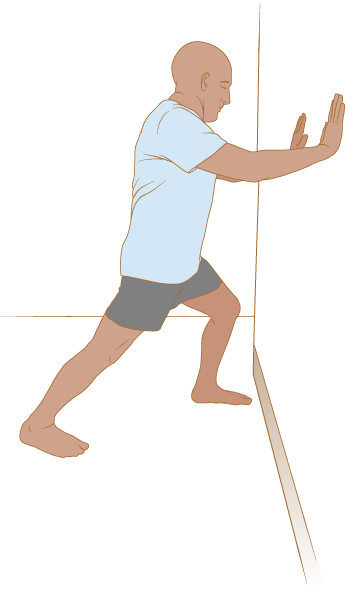This information explains how to do stretching exercises to help manage GVHD. In this resource, the word “you” refers to either you or your child.
Your healthcare provider will tell you:
- How long to hold each stretch.
- How many times to do each stretch.
- How many sets to do during each exercise session.
- How many exercise sessions to do each day.
- How many days to exercise each week.
Follow their instructions. Call them if you have any questions.
Your healthcare provider will talk with you before you start doing these stretches. Follow their instructions if they are different from the ones in this resource.
While you’re doing these stretches:
- Make sure all your movements are slow and steady. Don’t jerk or jolt.
- Only stretch to the point of slight discomfort. These stretches are not meant to be painful. If you feel pain, it means you’re pushing your body too far.
- You don’t need to do all these stretches at once. Take breaks to stretch throughout the day. You can use an alarm to remind yourself to stretch.
We know all this stretching can seem overwhelming. It may feel like it takes a lot of time and energy, but it’s worth it. Making an effort to stretch will help improve your well-being and recovery.
Tell a member of your care team if:
- Your range of motion is getting smaller. Range of motion means how far you can move or stretch a part of your body.
- You’re getting less flexible.
- You have new pain when you do these stretching exercises.
You may need to work with a physical therapist or occupational therapist instead of doing these stretches on your own.
Supplies
It’s helpful to have the following supplies:
- A full-size foam roller. Full size foam rollers are about 3 feet (1 meter) long. You can buy one online or at your local sports or exercise store.
- A rubber band. Start with one that’s fairly easy to stretch. Move to a heavier rubber band as you get stronger.
If you don’t have these supplies, tell your healthcare provider. They’ll tell you how to do the stretches without them or give you instructions for different stretches.
Neck Rotation
This stretch helps increase your neck’s range of motion. You can do this stretch either sitting down or standing up.
- Slowly turn your head to look over your shoulder (see Figure 1).
- Hold this position, then relax.
- Repeat steps 1 and 2, but look over your other shoulder.
- Repeat this movement.
This is 1 set.
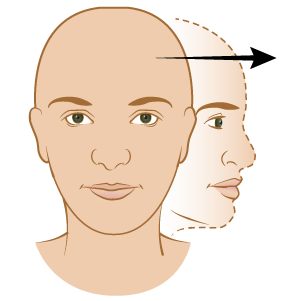
Upper Trapezius Stretch
This stretch helps make your upper trapezius muscle more flexible. This muscle helps move your neck. It also keeps your neck stable. You can do this stretch either sitting down or standing up.
- Reach your right hand behind your back. Rest your left hand on your head.
- Tilt your head toward your left shoulder until you feel a gentle stretch (see Figure 2).
- Hold this position, then relax.
- Repeat this movement.
- Repeat steps 1 to 4 with the other side of your body. Reach your left hand behind your back, rest your right hand on your head, and tilt your head towards your right shoulder.
This is 1 set.

Neck Flexion
This stretch helps increase your neck’s range of motion. You can do this stretch either sitting down or standing up.
- Bend your head forward (see Figure 3).
- Hold this position, then relax.
- Repeat this movement .
This is 1 set.

Neck Extension
This stretch helps increase your neck’s range of motion. You can do it either sitting down or standing up.
- Bend your head backward (see Figure 4).
- Hold this position, then relax.
- Repeat this movement.
This is 1 set.

Neck Retraction
This stretch helps make the muscles in your neck more flexible. You can do it either sitting down or standing up.
- Pull your head straight back, keeping your eyes and jaw level (see Figure 5).
- Hold this position, then relax.
- Repeat this movement.
This is 1 set.

Shoulder Rolls
This stretch helps increase your shoulders’ range of motion.
- Sit comfortably in a chair.
- Roll your shoulders in a backward circle (see Figure 6). Bring them forward, up, backward, and down.
- Repeat this movement.
- Repeat steps 1 to 3, but roll your shoulders in a forward circle. Bring them backward, up, forward, and down.
This is 1 set.

Shoulder Opener
This stretch helps make the muscles in your chest and upper back more flexible.
- Stand in a doorway. Place your forearms (from fingertip to elbow) on each side of the doorway.
- Keeping your forearms against the doorway, roll your shoulders back and down and press forward against the doorframe (see Figure 7).
- Hold this position, then relax.
- Repeat this movement.
This is 1 set.

Standing Shoulder Rotation
This stretch helps increase your shoulders’ range of motion.
- Stand with your feet shoulder-width apart for balance.
- Hold your arms out to the sides with your upper arms parallel to the floor, elbows bent at right angles (90 degrees), and palms facing down.
- Keeping your elbows bent, gently rotate your arms up so your palms are facing in front of you (see Figure 8). Stop if you feel pain.
- Keeping your elbows bent, gently rotate your arms down so your palms are facing behind you. Stop if you feel pain.
- Repeat this movement.
This is 1 set.
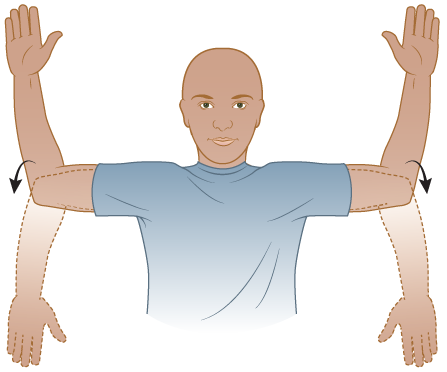
Doorway Shoulder Stretch
This stretch helps increase your shoulders’ range of motion.
- Stand in a doorway. Place the palm of your left hand against the door frame with your elbow bent at a right angle (90 degrees).
- Keeping your palm against the doorway, turn your body away from your hand until you feel a gentle stretch (see Figure 9).
- Hold this position, then relax.
- Repeat this movement.
- Repeat steps 1 to 4 with your right hand against the door frame.
This is 1 set.

Upper Back Foam Rolling
This stretch helps make the muscles in your chest and upper back more flexible. If you feel any pain while doing this stretch, stop right away.
-
Place a foam roller on the ground. Lie on it so it crosses your upper back. Move your feet towards your butt so your knees are bent. Place your hands behind your head (see Figure 10).
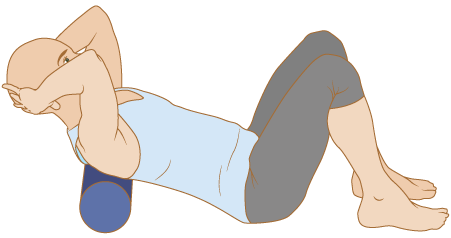
Figure 10. Lying on the foam roller -
Gently lean back, keeping your butt on the floor (see Figure 11). Hold this position.

Figure 11. Leaning back with your butt on the floor -
Lift your butt and push your feet against the floor to move your body over the foam roller (see Figure 12). Once the roller is in a different spot across your back, lower your butt to the floor. Hold this position for the same amount of time.
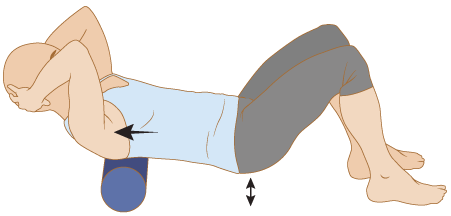
Figure 12. Moving your body over the foam roller - Repeat this movement to move the foam roller down your upper back.
This is 1 set.
Wall Roll-Up
This stretch helps make the muscles in your chest and upper back more flexible.
- Stand with your back toward a wall. Hold a foam roller behind you with one end even with your butt and the other pointing up toward your head.
- Bend your knees and back up toward the wall until the foam roller is pressed between your back and the wall.
- Keeping your knees bent and your butt pressed against the foam roller, bend over with your back rounded.
-
Starting from the bottom of your spine, slowly straighten your back (see Figure 13). Press your spine against the foam roller as you go. Keep your knees bent.

Figure 13. Straightening your back -
Once your back is straight, lift your arms in front of you over your head (see Figure 14). Keep your spine pressed against the foam roller. Hold this position, then relax.

Figure 14. Lifting your arms over your head - Repeat steps 3 to 5.
This is 1 set.
Finger Flexion and Extension
This stretch helps increase your hands’ range of motion. You can do it with one or both hands at a time.
- Starting with the tips of your fingers, slowly bend your fingers into a fist (see Figure 15). Hold this position. Then, relax.
- Straighten your fingers as far as you can. Hold this position for the same amount of time. Then, relax.
- Repeat this movement.
This is 1 set.

Prayer Stretch
This stretch helps make the muscles in your wrist more flexible.
- Sit with your elbows resting on a table. Place your palms together.
- Keeping your palms together, slowly slide your elbows apart and lower your hands toward the table until you feel a stretch (see Figure 16).
- Hold this position, then relax.
- Repeat this movement.
This is 1 set.

Wrist Flexor Stretch
This stretch helps make the muscles in your wrist more flexible.
- Stand with your palms resting comfortably on a table.
- Slowly move your upper body forward over your hands until you feel a gentle stretch in your forearms (see Figure 17).
- Hold this position, then relax.
- Repeat this movement.
This is 1 set.

Forearm Rotation
This stretch helps increase your hands’ range of motion. You can do it with one or both arms at a time.
- Bend your elbow and hold your arm in front of you like you’re going to shake someone’s hand.
- Keeping your elbow tucked close to your body, slowly rotate your palm downward until you feel a stretch (see Figure 18). Hold this position, then relax.
- Keeping your elbow tucked close to your body, slowly rotate your palm upward until you feel a stretch. Hold this position for the same amount of time. Then, relax.
- Repeat this movement.
This is 1 set.

Wrist Radial and Ulnar Deviation
This stretch helps increase your hands’ range of motion. You can do it with one or both wrists at a time.
- Gently bend your wrist(s) to one side as far as you can (see Figure 19). Hold this position, then relax.
- Gently bend your wrist(s) to the other side as far as you can. Hold this position for the same amount of time. Then, relax.
- Repeat steps 1 and 2.
This is 1 set.
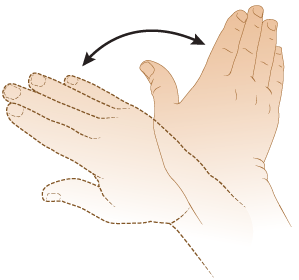
Rubber Band Stretch
This stretch increases your hand and fingers’ range of motion.
-
Cup your hand to bring your fingers and thumb together. Place a rubber band around them (see Figure 20).
- It’s OK to do this stretch without a rubber band. You can do it with both hands at once if you’re not using a rubber band.
-
Gently spread your thumb and fingers apart (see Figure 21).

Figure 20. Placing a rubber band around your fingers and thumb 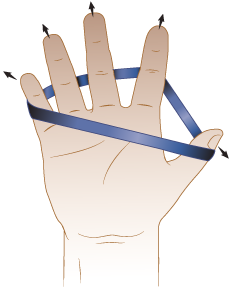
Figure 21. Spreading your finger and thumbs apart - Hold this position, then relax.
- Repeat this movement.
- Repeat steps 1 to 4 with your other hand.
This is 1 set.
Hip Flexor Stretch
This exercise helps make your hip flexors more flexible. Your hip flexors are a group of muscles toward the front of your hip. They pull your leg forward and up toward your body.
- Stand facing a wall with one or both hands on the wall for support. Step one of your feet toward the wall.
- Bend both your knees, lift your chest, and rotate your pelvis forward (see Figure 22). Do not arch your back.
- Hold this position, then relax.
- Repeat this movement.
- Switch your legs’ positions and repeat steps 1 to 4.
This is 1 set.

Hamstring Stretch
This exercise stretches your hamstrings. Your hamstrings are a group of muscles in the back of your thigh that help move your knee and hip.
- Sit on the edge of your couch or bed. Keeping one foot on the floor, extend your other leg in front of you on the bed or couch. Place your hands on that thigh for support (see Figure 23).
- Keeping your torso straight, lean forward and slide your hands down your leg until you feel a stretch in the back of your thigh.
- Hold this position, then relax.
- Repeat this movement.
- Turn so you’re facing the other way. Repeat steps 1 to 4 with your other leg.
This is 1 set.

Calf Stretch
This exercise stretches the main muscle in your calf. This muscle helps move your ankle and knee.
- Stand facing a wall with both hands on the wall for support. Step one of your feet toward the wall.
- Turn your back heel slightly out to the side. Bend your front leg.
- Keeping your heels on floor, lean into the wall until you feel a stretch in your back calf.
- Hold this position, then relax.
- Repeat this movement.
- Switch your legs’ positions. Repeat steps 1 to 5 with your other leg.
This is 1 set.
